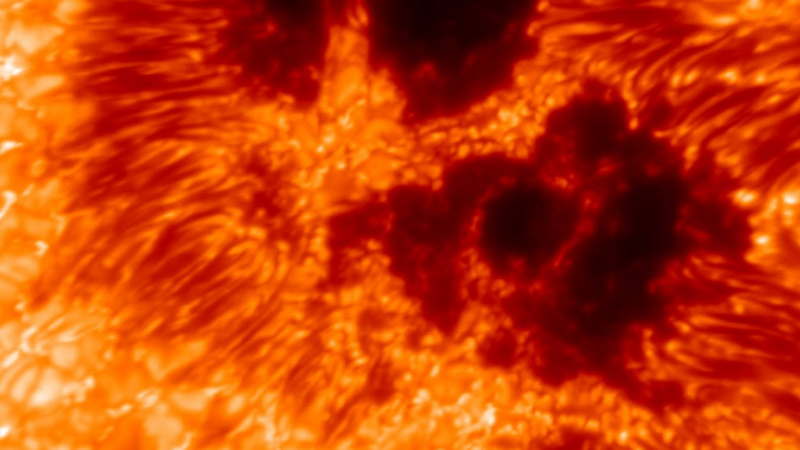A telescope’s powerful new tool may offer a better way to predict solar storms
The most powerful solar telescope in the world has recorded a major milestone atop an active volcano in Hawaii, capturing a detailed image of a cluster of sunspots with the telescope’s new Visible Tunable Filter (VTF).
Scientists hope that in the future the instrument will help predict powerful and potentially damaging solar storms.
The Daniel K. Inouye Telescope snapped the photo of the roaring star late last month from the summit of the Haleakalā volcano in Maui.
The National Solar Observatory (NSO), which operates the telescope, said that the image was taken during technical testing and that the VTF is not yet even fully operational. But the fact that the telescope was able to capture such an image at this phase shows how powerful the device will eventually be.

The NSO describes sunspots as “areas of intense magnetic activity” that can trigger solar flares and coronal mass ejections — phenomena that can have damaging effects on Earth’s radio communications and electrical grids.
“After all these years of work, VTF is a great success for me,” said Thomas Kentischer, co-principal investigator at Germany’s Leibniz Institute for Solar Physics, where the VTF was designed.
“I hope this instrument will become a powerful tool for scientists to answer outstanding questions on solar physics,” Kentischer added.

Matthias Schubert, a project scientist at the institute, spoke poetically of the highly technical device.
“The significance of the technological achievement is such that one could easily argue the VTF is the Inouye Solar Telescope’s heart, and it is finally beating at its forever place,” he said.
The NSO described the sun as “a plasma laboratory right on our doorstep” and said that the VTF’s image gives promise that with time, the telescope will help scientists better predict when powerful solar storms are coming toward Earth in order to mitigate the damage these geomagnetic disturbances might cause.
While the team of researchers hailed the success of the telescope, the road to its construction was marked by years of protests against the placement of yet another massive device on what many native Hawaiians view as sacred land.

His brother’s mental illness isolated his family. Now he’s helping other caregivers
When it comes to serious mental illness, family caregivers are crucial partners. But often, they must fend for themselves. A new solution offers them support.
Out with the mayo: How Ukrainians reclaim holiday food
For many people from former Soviet countries, New Year's is a big holiday feast time. A Ukrainian restaurant in Washington gives NPR a taste of what's on the menu.
Farmers are about to pay a lot more for health insurance
Tariffs, inflation, and other federal policies have battered U.S. farmers' bottom lines. Now many farmers say the expiration of federal health care subsidies will make their coverage unaffordable.
50 wonderful things from 2025
Each year, critic Linda Holmes looks back on the year and compiles a list of the things that brought her joy.
Why do we make New Year’s resolutions? A brief history of a long tradition
One of the earliest mentions of New Year's resolutions appeared in a Boston newspaper in 1813. But the practice itself can be traced back to the Babylonians.
Judge orders new trial for Alabama woman sentenced to 18 years in prison after stillbirth
Lee County Circuit Judge Jeffrey Tickal vacated Brooke Shoemaker’s 2020 conviction for chemical endangerment of a child resulting in death. Tickal said Shoemaker's attorneys presented credible new evidence that the infection caused the stillbirth.








